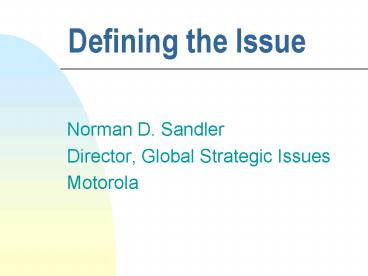Defining the Issue - PowerPoint PPT Presentation
1 / 16
Title:
Defining the Issue
Description:
Research on RF effects dates back decades -- from exploration of therapeutic ... (Reynard, 1993) CITEL March 5, 2001. 4. Dimensions of the Issue. Science. Litigation ... – PowerPoint PPT presentation
Number of Views:25
Avg rating:3.0/5.0
Title: Defining the Issue
1
Defining the Issue
- Norman D. Sandler
- Director, Global Strategic Issues
- Motorola
2
Origins of the Issue
- Historical context
- Research on RF effects dates back decades --
from exploration of therapeutic innovations more
than 70 years ago to the advent of radar and more
recent commercial applications. - In 1993, U.S. litigation raised mobile phone
health issues. The lawsuit went away. The issue
did not. In fact, it has evolved into a set of
issues and challenges for regulation,
communication and public understanding.
3
Evolution of the Issue
RF (Reynard, 1993)
- ELF (Wertheimer/Leeper, 1979)
- Handsets
- Adverse Health(Cancer)
- Pathological Effects(Cancer)
- Direct Other Effects(Interference)
- EMF (Brodeur, 1989)
- Antenna Sites
- Non-Health Effects(Interference)
- Non-Pathological Effects(Headaches)
- Other Unintended Consequences(Driver Safety)
4
Dimensions of the Issue
Science
Litigation
Public Attitudes
Public Policy
5
Basic Observations
- Issues are surfacing in more places in more forms
- Public policy challenge is multinational,
multidimensional - Needed global perspective with global
participation
6
Overview
- Where are questions emerging?
- Science
- Government
- Media
- Marketplace
- Why?
- Reports of new research findings
- Growth, advancement of technology
- Government recommendations
- Legal developments
7
Public Policy Challenges
- The issues are or seem -- complex
- Public information subject to media filter
- Media seize on anomalous views, findings
- Information spreads fast, far, wide
- Frequent result misunderstanding,
misinformation, questions and confusion
8
Recent Media
- Which? Report, April 2000, November 2000
- Headsets channel three times as much radiation
from the mobile telephone into the user's head - Improper modeling of the human body (Head only)
- Used survey meter instead of miniature E-field
probe - South China Morning Post, April 2000
- Radiation could damage human cells and cause
mutation. - Dr. Chan Yuk-wah of University of Hong Kong
responded that he was referring to ionizing
radiation only.
9
Recent Media
- Brain tumor study
- Dr. George Carlo cell-phone use could be
associated with a rare type of brain cancer - Joshua Muscat This study did not find evidence
that cell phone use increases the risk of brain
cancer. - Memory effects reported by Dr. Henry Lai
- High peak power pulse fields induce auditory
effect - Cell phone signals can not induce auditory effect
- Effects from high peak power cannot be
extrapolated to low-power devices
10
Key Issues
- Current state of the science depth, breadth and
overall status of research - The scientific process how it works and how it
often is misinterpreted - Standards how they are established, how they are
applied and how they serve the public interest - Standards harmonization recognizing that a
global issue demands global approaches
11
Scientific Research
- State of the science
- Scope of the science
- The scientific process
12
RF Exposure Standards
- How they are set
- What they mean
- How they are applied
- The quest for harmonization
13
Recent Developments
- Science what the experts are saying
- Regulations what the agencies are doing
- Communications dealing with the public
14
Marketplace Issues
- Exposure level (SAR) reporting
- Product labeling
- Use of phones by children
- The precautionary approach
- Antenna sites
- Public confidence in standards
- EMC
15
SAR What It Means, What It Doesnt Mean
- SAR is a measurement of compliance, NOT a
measurement of safety. - SAR measurements are performed to assure that
radio products meet recognized limits. - Independent standard-setting organizations,
government agencies and health authorities do not
regard differences in SAR as differences in
safety. - Regrettably, these points are lost in media
accounts of plans for SAR reporting.
16
SAR Reporting The Facts
- No health warnings or radiation labels
- Voluntary no government mandates
- On the product box certification of compliance
with applicable standards, similar to what
appears in user manuals - Inside the box explanation of SAR and SAR values
for the product in question - Timing process in place for new products in the
U.S. and commitment to a global approach in 2001































